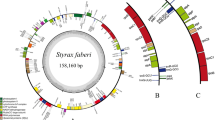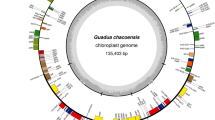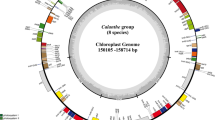Abstract
Main conclusion
This study reported seven new plastomes from Impatiens and observed three highly variable regions for phylogeny and DNA barcoding, which resolved the relationships among sections of subgenus Impatiens.
Abstract
Impatiens L. (Balsaminaceae, Ericales) is one of the largest and most diverse genera of angiosperms, widely known for its taxonomic difficulty. In this study, we reevaluated the infrageneric relationships within the genus Impatiens, using complete plastome sequence data. Seven complete plastomes of Impatiens (representing 6 species) were newly sequenced and characterized along with 20 previously published plastomes of other Impatiens species, plus 2 plastomes of outgroups (Hydrocera triflora, Balsaminaceae; Marcgravia coriacea, Marcgraviaceae). The total size of these 29 plastomes ranged from 151,538 bp to 152,917 bp, except 2 samples of Impatiens morsei, which exhibited a shorter length and lost some genes encoding NADH dehydrogenase subunits. Moreover, the number of simple sequence repeats (SSRs) ranged from 51 to 113, and the number of long repeats from 17 to 26. In addition, three highly variable regions were identified (trnG-GCC (The previous one), ndhF–rpl32–trnL-UGA–ccsA, and ycf1). Our phylogenomic analysis based on 80 plastome-derived protein-coding genes strongly supported the monophyly of Impatiens and its two subgenera (Clavicarpa and Impatiens), and fully resolved relationships among the six (out of seven) sampled sections of subgenus Impatiens. Overall, the plastome DNA markers and phylogenetic results reported in this study will facilitate future identification, taxonomic and DNA barcoding studies in Impatiens as well as evolutionary studies in Balsaminaceae.







Similar content being viewed by others
Data availability
The 7 plastome sequence data generated in this study are available in GenBank of the National Center for Biotechnology Information (NCBI) (https://www.ncbi.nlm.nih.gov/nuccore) under the access numbers: ON186542, OP022554–OP022559.
References
Ahmed I, Biggs PJ, Matthews PJ, Collins LJ, Hendy MD, Lockhart PJ (2012) Mutational dynamics of aroid chloroplast genomes. Genome Biol Evol 4:1316–1323. https://doi.org/10.1093/gbe/evs110
Amenu SG, Wei N, Wu L, Oyebanji O, Hu GW, Zhou YD, Wang QF (2022) Phylogenomic and comparative analyses of Coffeeae alliance (Rubiaceae): deep insights into phylogenetic relationships and plastome evolution. BMC Plant Biol 22:88. https://doi.org/10.1186/s12870-022-03480-5
Amiryousefi A, Hyvönen J, Poczai P (2018) IRscope: an online program to visualize the junction sites of chloroplast genomes. Bioinformatics 34:3030–3031. https://doi.org/10.1093/bioinformatics/bty220
Bankevich A, Nurk S, Antipov D, Gurevich AA, Dvorkin M, Kulikov AS, Lesin VM, Nikolenko SI, Pham S, Prjibelski AD, Pyshkin AV, Sirotkin AV, Vyahhi N, Tesler G, Alekseyev MA, Pevzner PA (2012) SPAdes: a new genome assembly algorithm and its applications to single-cell sequencing. J Comput Biol 19:455–477. https://doi.org/10.1089/cmb.2012.0021
Beier S, Thiel T, Münch T, Scholz U, Mascher M (2017) MISA-web: a web server for microsatellite prediction. Bioinformatics 33:2583–2585. https://doi.org/10.1093/bioinformatics/btx198
Bock R (2007). In: Bock R (ed) Structure, function, and inheritance of plastid genomes. Springer, Berlin, pp 29–63
Byng JW, Chase MW, Christenhusz M, Fay MF, Judd WS, Mabberley DJ, Sennikov AN, Soltis DE, Soltis PS, Stevens PF, Briggs B, Brockington S, Chautems A, Clark JC, Conran J, Haston E, Moller M, Moore M, Olmstead R, Perret M, Skog L, Smith J, Tank D, Vorontsova M, Weber A, Angiosperm PG (2016) An update of the angiosperm phylogeny group classification for the orders and families of flowering plants: APG IV. Bot J Linn Soc 181:1–20. https://doi.org/10.1111/boj.12385
Cai X, Yi R, Zhuang Y, Cong Y, Kuang R, Liu K (2013) Seed coat micromorphology characteristics of Impatiens L. and its systematic significance. Acta Horticulturae Sinica 40:1337–1348
Chen YL (1978) Notulae de genere Impatiens L. florae Sinicae. Acta Phytotax Sin 16(2):36–55
Darling AC, Mau B, Blattner FR, Perna NT (2004) Mauve: multiple alignment of conserved genomic sequence with rearrangements. Genome Res 14:1394–1403. https://doi.org/10.1101/gr.2289704
Fu CH, Chen XY, Li TJ, Zhou AP (2022) Characterizing the complete chloroplast genome of the Impatiens davidii (Balsaminaceae). Mitochondrial DNA B 7:466–467. https://doi.org/10.1080/23802359.2022.2048211
Fujihashi H, Akiyama S, Ohba H (2002) Origin and relationships of the Sino-Himalayan Impatiens (Balsaminaceae) based on molecular phylogenetic analysis, chromosome numbers and gross morphology. J Jpn Bot 77:284–295
Greiner S, Lehwark P, Bock R (2019) OrganellarGenomeDRAW (OGDRAW) version 1.3.1: expanded toolkit for the graphical visualization of organellar genomes. Nucleic Acids Res 47:W59–W64. https://doi.org/10.1093/nar/gkz238
Grey-Wilson C (1980) Impatiens in Papuasia: studies in Balsaminaceae: I. Kew Bull 34:661
Guo X, Qu X, Zhang X, Fan S (2022) Comparative and phylogenetic analysis of complete plastomes among aristidoideae species (Poaceae). Biology 11:63. https://doi.org/10.3390/biology11010063
Hooker JD (1908) Les espèces du genre “Impatiens” dans l’herbier du Muséum de Paris. Nouvelles Archives Du Muséum D’histoire Naturelle 4 10:233-272: 39
Janssens S, Geuten K, Yuan YM, Song Y, Kupfer P, Smets E (2006) Phylogenetics of impatiens and Hydrocera (Balsaminaceae) using chloroplast atpB-rbcL Spacer sequences. Syst Bot 31:171–180. https://doi.org/10.1600/036364406775971796
Janssens SB, Smets EF, Vrijdaghs A (2012) Floral development of Hydrocera and Impatiens reveals evolutionary trends in the most early diverged lineages of the Balsaminaceae. Ann Bot-London 109:1285–1296. https://doi.org/10.1093/aob/mcs065
Jiang H, Zhuang Z, Hou B, Shi B, Shu C, Chen L, Shi G, Zhang W (2017) Adverse effects of hydroalcoholic extracts and the major components in the stems of Impatiens balsamina L. on Caenorhabditis elegans. Evid-Based Compl Alt 2017:1–10. https://doi.org/10.1155/2017/4245830
Jin JJ, Yu WB, Yang JB, Song Y, DePamphilis CW, Yi TS, Li DZ (2020) GetOrganelle: a fast and versatile toolkit for accurate de novo assembly of organelle genomes. Genome Biol 21:241. https://doi.org/10.1186/s13059-020-02154-5
Katoh K, Standley DM (2013) MAFFT multiple sequence alignment software version 7: improvements in performance and usability. Mol Biol Evol 30:772–780. https://doi.org/10.1093/molbev/mst010
Kearse M, Moir R, Wilson A, Stones-Havas S, Cheung M, Sturrock S, Buxton S, Cooper A, Markowitz S, Duran C, Thierer T, Ashton B, Meintjes P, Drummond A (2012) Geneious basic: an integrated and extendable desktop software platform for the organization and analysis of sequence data. Bioinformatics 28:1647–1649. https://doi.org/10.1093/bioinformatics/bts199
Kim CS, Bae M, Oh J, Subedi L, Suh WS, Choi SZ, Son MW, Kim SY, Choi SU, Oh DC, Lee KR (2017) Anti-neurodegenerative biflavonoid glycosides from Impatiens balsamina. J Nat Prod 80:471–478. https://doi.org/10.1021/acs.jnatprod.6b00981
Kurtz S, Choudhuri JV, Ohlebusch E, Schleiermacher C, Stoye J, Giegerich R (2001) REPuter: the manifold applications of repeat analysis on a genomic scale. Nucleic Acids Res 29:4633–4642. https://doi.org/10.1093/nar/29.22.4633
Li Z, Saina J, Gichira A, Kyalo C, Wang Q, Chen J (2018) Comparative genomics of the Balsaminaceae sister genera Hydrocera triflora and Impatiens pinfanensis. Int J Mol Sci 19:319. https://doi.org/10.3390/ijms19010319
Lin CS, Chen J, Chiu CC, Hsiao H, Yang CJ, Jin XH, Leebens-Mack J, de Pamphilis CW, Huang YT, Yang LH, Chang WJ, Kui L, Wong G, Hu JM, Wang W, Shih MC (2017) Concomitant loss of NDH complex-related genes within chloroplast and nuclear genomes in some orchids. Plant J 90:994–1006. https://doi.org/10.1111/tpj.13525
Liu C, Lei J, Jiang Q, Zhou S, He X (2022a) The complete plastomes of seven Peucedanum plants: comparative and phylogenetic analyses for the Peucedanum genus. BMC Plant Biol 22:116. https://doi.org/10.1186/s12870-022-03488-x
Liu J, Lindstrom AJ, Gong X (2022b) Towards the plastome evolution and phylogeny of Cycas L. (Cycadaceae): molecular-morphology discordance and gene tree space analysis. BMC Plant Biol 22:101. https://doi.org/10.1186/s12870-022-03491-2
Luo C, Huang W, Sun H, Yer H, Li X, Li Y, Yan B, Wang Q, Wen Y, Huang M, Huang H (2021) Comparative chloroplast genome analysis of Impatiens species (Balsaminaceae) in the karst area of China: insights into genome evolution and phylogenomic implications. BMC Genom 22:571. https://doi.org/10.1186/s12864-021-07807-8
Lyu XL, Liu Y (2020) Nonoptimal codon usage is critical for protein structure and function of the master general amino acid control regulator CPC-1. Mbio 11:e2605–e2620. https://doi.org/10.1128/mBio.02605-20
Miller MA, Pfeiffer W, Schwartz T (2010) Creating the CIPRES science gateway for inference of large phylogenetic trees. 2010 gateway computing environments workshop (GCE). Ieee, New York, pp 1–8
Minh BQ, Schmidt HA, Chernomor O, Schrempf D, Woodhams MD, von Haeseler A, Lanfear R (2020) IQ-TREE 2: new models and efficient methods for phylogenetic inference in the genomic era. Mol Biol Evol 37:1530–1534. https://doi.org/10.1093/molbev/msaa015
Rahelivololona EM, Fischer E, Janssens SB, Sylvain GR (2018) Phylogeny, infrageneric classification and species delimitation in the Malagasy Impatiens (Balsaminaceae). Phytokeys. https://doi.org/10.3897/phytokeys.110.28216
Rambaut A, Drummond AJ, Dong X, Guy B, Suchard MA (2018) Posterior summarisation in Bayesian phylogenetics using Tracer 1.7. Syst Biol 5:901–904
Ramzan M, Sarwar S, Kauser N, Saba R, Hussain I, Shah AA, Aslam MN, Alkahtani J, Alwahibi MS (2020) Assessment of Inter simple sequence repeat (ISSR) and simple sequence repeat (SSR) markers to reveal genetic diversity among Tamarix ecotypes. J King Saud Univ Sci 32:3437–3446. https://doi.org/10.1016/j.jksus.2020.10.003
Ren J, Tian J, Jiang H, Zhu X, Mutie FM, Wanga VO, Ding S, Yang J, Dong X, Chen L, Cai X, Hu G (2022) Comparative and phylogenetic analysis based on the chloroplast genome of Coleanthus subtilis (Tratt.) seidel, a protected rare species of monotypic genus. Front Plant Sci 13:828467. https://doi.org/10.3389/fpls.2022.828467
Revell LJ (2011) Phytools: an R package for phylogenetic comparative biology (and other things). Methods Ecol Evol 3:217–223
Rozas J, Ferrer-Mata A, Sánchez-DelBarrio JC, Guirao-Rico S, Librado P, Ramos-Onsins SE, Sánchez-Gracia A (2017) DnaSP 6: DNA sequence polymorphism analysis of large data sets. Mol Biol Evol 34:3299–3302. https://doi.org/10.1093/molbev/msx248
Schneider JV, Paule J, Jungcurt T, Cardoso D, Amorim AM, Berberich T, Zizka G (2021) Resolving recalcitrant clades in the pantropical ochnaceae: insights from comparative phylogenomics of plastome and nuclear genomic data derived from targeted sequencing. Front Plant Sci. https://doi.org/10.3389/fpls.2021.638650
Sharp PM, Wen-Hsiung L (1986) Codon usage in regulatory genes in Escherichia coli does not reflect selection for ‘rare’ codons. Nucleic Acids Res 19:7737–7749
Shaw J, Shafer HL, Leonard OR, Kovach MJ, Schorr M, Morris AB (2014) Chloroplast DNA sequence utility for the lowest phylogenetic and phylogeographic inferences in angiosperms: the tortoise and the hare IV. Am J Bot 101:1987–2004
Shen XF, Wu ML, Liao BS, Liu ZX, Bai R, Xiao SM, Li XW, Zhang BL, Xu J, Chen SL (2017) Complete chloroplast genome sequence and phylogenetic analysis of the medicinal plant Artemisia annua. Molecules 22:1330. https://doi.org/10.3390/molecules22081330
Silva SR, Michael TP, Meer EJ, Pinheiro DG, Varani AM, Miranda VFO (2018) Comparative genomic analysis of Genlisea (corkscrew plants—Lentibulariaceae) chloroplast genomes reveals an increasing loss of the ndh genes. PLoS ONE 13:e190321. https://doi.org/10.1371/journal.pone.0190321
Somaratne Y, Guan DL, Wang WQ, Zhao L, Xu SQ (2020) The complete chloroplast genomes of two Lespedeza species: insights into codon usage bias, RNA editing sites, and phylogenetic relationships in Desmodieae (Fabaceae: Papilionoideae). Plants Basel. https://doi.org/10.3390/plants9010051
Song YX, Peng S, Cong YY, Zheng YM (2021) Impatiens rapiformis, a new species of Impatiens with root tuber from Yunnan. China Nord J Bot 39:3151. https://doi.org/10.1111/njb.03151
Song Y, Zhao W, Xu J, Li M, Zhang Y (2022) Chloroplast genome evolution and species identification of Styrax (Styracaceae). Biomed Res Int 2022:1–13. https://doi.org/10.1155/2022/5364094
Sun Y, Zou P, Jiang N, Fang Y, Liu G (2022) Comparative analysis of the complete chloroplast genomes of nine Paphiopedilum species. Front Genet 12:772415. https://doi.org/10.3389/fgene.2021.772415
Wang J, Lu Y, Xu Y, Jin S, Jin X (2020) Impatiens wuyiensis (Balsaminaceae), a new species from Fujian of Southeast China, based on morphological and molecular evidences. Bot Stud 61:29. https://doi.org/10.1186/s40529-020-00306-1
Wang Z, Wu PP, Liu CC, Guo K, Yu SX (2022a) Impatiens nushanensis (Balsaminaceae), a new species from Yunnan, China. Phytotaxa 545:186–196. https://doi.org/10.11646/phytotaxa.545.2.7
Wang ZW, Wang Q, Xu RH, Zhang Y, Li XC (2022b) Impatiens chenmoui (Balsaminaceae) a new species from southern Yunnan China. PhytoKeys 214:83–95. https://doi.org/10.3897/phytokeys.214.94898
Wick RR, Schultz MB, Zobel J, Holt KE (2015) Bandage: interactive visualization of de novo genome assemblies. Bioinformatics 31:3350–3352. https://doi.org/10.1093/bioinformatics/btv383
Xu Z, Xin T, Bartels D, Li Y, Gu W, Yao H, Liu S, Yu H, Pu X, Zhou J, Xu J, Xi C, Lei H, Song J, Chen S (2018) Genome analysis of the ancient tracheophyte Selaginella tamariscina reveals evolutionary features relevant to the acquisition of desiccation tolerance. Mol Plant 11:983–994. https://doi.org/10.1016/j.molp.2018.05.003
Yang J, Hu G, Hu G (2022) Comparative genomics and phylogenetic relationships of two endemic and endangered species (Handeliodendron bodinieri and Eurycorymbus cavaleriei) of two monotypic genera within Sapindales. BMC Genom 23:27. https://doi.org/10.1186/s12864-021-08259-w
Yin J, Cai X, Liu Y, Li S (2018) AHP-based ornamental value evaluation of sect. Calcareimontana (Impatiens L). Northern Horticulture 2018(22):93–97. (in Chinese with English abstract)
Yu SX, Janssens SB, Zhu XY, Liden M, Gao TG, Wang W (2016) Phylogeny of Impatiens (Balsaminaceae): integrating molecular and morphological evidence into a new classification. Cladistics 32:179–197. https://doi.org/10.1111/cla.12119
Yuan YM, Song Y, Geuten K, Rahelivololona E, Wohlhauser S, Fischer E, Smets E, Kupfer P (2004) Phylogeny and biogeography of Balsaminaceae inferred from ITS sequences. Taxon 53:391–403. https://doi.org/10.2307/4135617
Zalapa JE, Cuevas H, Zhu HY, Steffan S, Senalik D, Zeldin E, McCown B, Harbut R, Simon P (2012) Using next-generation sequencing approaches to isolate simple sequence repeat (SSR) loci in the plant sciences. Am J Bot 99:193–208. https://doi.org/10.3732/ajb.1100394
Zhang Y, Han L, Yang C, Yin Z, Tian X, Qian Z, Li G (2022a) Comparative chloroplast genome analysis of medicinally important Veratrum (Melanthiaceae) in China: insights into genomic characterization and phylogenetic relationships. Plant Divers 44:70–82. https://doi.org/10.1016/j.pld.2021.05.004
Zhang Z, Tao M, Shan X, Pan Y, Sun C, Song L, Pei X, Jing Z, Dai Z (2022b) Characterization of the complete chloroplast genome of Brassica oleracea var. italica and phylogenetic relationships in Brassicaceae. PLoS ONE 17:e263310. https://doi.org/10.1371/journal.pone.0263310
Zhou M, Guo J, Cha J, Chae M, Chen S, Barral JM, Sachs MS, Liu Y (2013) Non-optimal codon usage affects expression, structure and function of clock protein FRQ. Nature 495:111–115
Acknowledgements
We thank Dr. Zhe-Chen Qi, Yu Feng, Rui-Sen Lu, Mr. Zi-Han Liu and Hai-Lei Zheng for helping with the fieldwork. This research was supported by the National Natural Science Foundation of China (Grant No. 31970225).
Author information
Authors and Affiliations
Corresponding author
Ethics declarations
Conflict of interest
The authors declare no conflict of interest.
Ethical approval
Not applicable.
Consent to participate
All the authors consent to participate this study.
Consent for publication
All the authors consent for this publication.
Additional information
Communicated by Anastasios Melis.
Publisher's Note
Springer Nature remains neutral with regard to jurisdictional claims in published maps and institutional affiliations.
Supplementary Information
Below is the link to the electronic supplementary material.
425_2023_4078_MOESM2_ESM.rar
Supplementary file2 Summary of Impatiens sampling information and Illumina sequencing reports. Long repeats identified in the 27 Impatiens plastomes. Simple sequence repeats (SSRs) identified in the 27 Impatiens plastomes. The relative synonymous codon usage (RSCU) and total number of the codons of 27 Impatiens plastomes, plus plastomes. The nucleotide diversity (Pi) values of 27 Impatiens plastomes calculated by the sliding window method in DnaSP with a step size of 200 bp and a window length of 800 bp. (RAR 26 KB)
425_2023_4078_MOESM3_ESM.rar
Supplementary file3 MAUVE multiple alignment of 27 Impatiens plastomes, with Hydrocera triflora (Balsaminaceae) and Marcgravia coriacea (Marcgraviaceae) as outgroups. Analysis of the expansion and contraction of inverted repeat (IR) regions in 27 Impatiens plastomes with Hydrocera triflora (Balsaminaceae) and Marcgravia coriacea (Marcgraviaceae) as outgroups. The numbers next to each gene indicate the distance (in bp) to the boundary of particular regions (LSC, large single-copy; SSC, small single-copy; IR, inverted repeats; see vertical lines) or the length of these genes (in bp). Maximum Likelihood (ML) tree of Impatiens based on whole plastomes. The bootstrap support value (BS) of branches without labels is 100%. Bayesian Inference (BI) tree of Impatiens based on the highly variable ycf1 region. The topology of the Maximum Likelihood (ML) tree is the same. The bootstrap support (BS) and posterior probability (PP) values of branches without labels are 100% and 1.0, respectively. Bayesian Inference (BI) tree of Impatiens based on the highly variable ndhF–rpl32–trnL-UGA–ccsA region. The topology of the Maximum Likelihood (ML) tree is the same. The bootstrap support (BS) and posterior probability (PP) values of branches without labels are 100% or 1.0, respectively. Maximum Likelihood (ML) tree of Impatiens based on the highly variable trnG-GCC region. The bootstrap support (BS) value of branches without labels is 100%. Bayesian Inference (BI) tree of Impatiens base on highly variable region trnG-GCC. The posterior probability (PP) value of branches without labels is 1.0. (RAR 18582 KB)
Rights and permissions
Springer Nature or its licensor (e.g. a society or other partner) holds exclusive rights to this article under a publishing agreement with the author(s) or other rightsholder(s); author self-archiving of the accepted manuscript version of this article is solely governed by the terms of such publishing agreement and applicable law.
About this article
Cite this article
Qiu, H., Zhang, ZH., Wang, MZ. et al. Plastome evolution and phylogenomics of Impatiens (Balsaminaceae). Planta 257, 45 (2023). https://doi.org/10.1007/s00425-023-04078-3
Received:
Accepted:
Published:
DOI: https://doi.org/10.1007/s00425-023-04078-3




